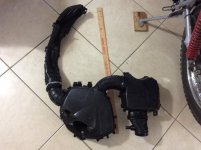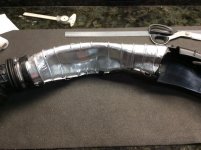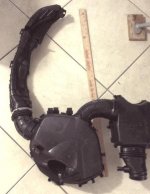The opening is behind where you chopped up the plastic. The item you heated and distorted partially feeds the actual air intake. Once you disassemble and remove the duct, it will be apparent how well the inlet was designed. It uses positive pressure inside the radiator nacelle, but forward of the radiator exhaust heated air, to feed the engine air.
The air inlet location on the 2014 to 2019 is superior to the 2020 and later RT series. These 2014 / 2019 models have a true positive pressure inlet with adequate duct cross section for the size of the throttle body. Heat is what kills the design.
The 2020 and after use essentially the same primary airbox, but Can Am omitted the inlet duct. Therefore a 2020 and after draws intake air from under the bodywork. Simple aerodynamics would suggest this is a low pressure area, not ideal for positive induction air feed to the airbox. Can Am moved the radiators outboard of the bodywork in 2020. An obvious attempt to cool the underside of the bodywork. Because of this, adding an elbow scoop as Mike did, may induce better air entry , but also may introduce heated air.
From an efficiency standpoint, the more tightly designed body shape of the pre 2020 Spyder RT, and the smaller overall size, plus the more compact radiator placement should make the 2014 / 2019 better aerodynamically and therefore more efficient. What kills it though is heat being added to the cold air induction, robbing a lot of available power. The heat reduces air density. Less dense air makes less power. You can modify the oem inlet to be twice as large, the location is not going to add any pressure or flow beyond what oem has. Even with that, once within the system, that trapped air is quickly heated.
If the oem primary airbox were to have an exhaust added, so cool air could constantly flow while moving, vs being dead ended (except for consumed air), this may lower airbox and air duct temp somewhat. This airbox exhaust would need to exit at a know point that would not allow heated air from under the bodywork to enter the airbox.



